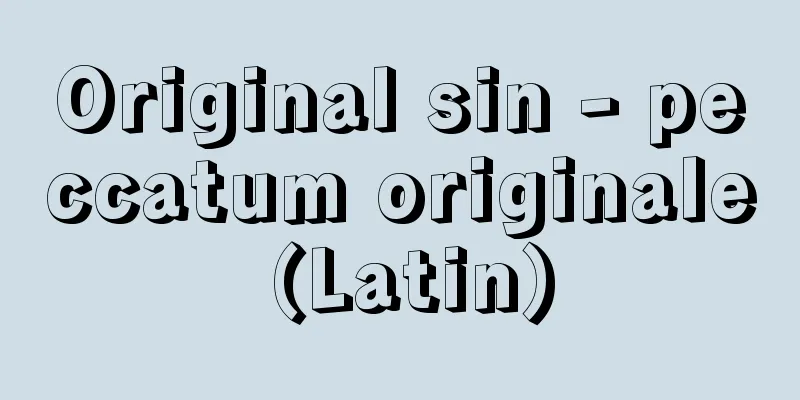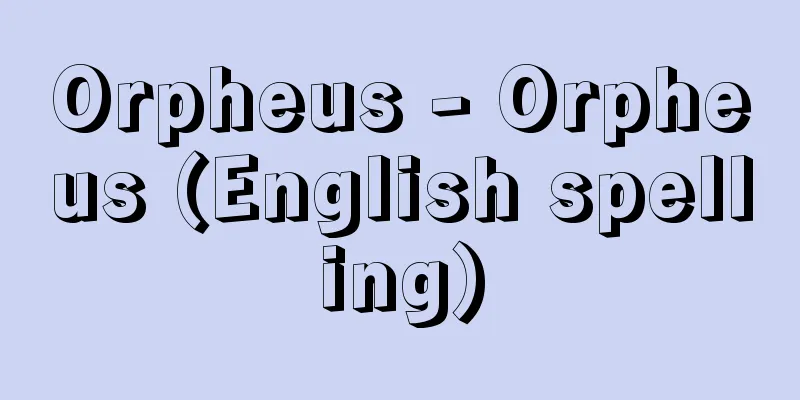Original sin - peccatum originale (Latin)

|
A Christian doctrine. It refers to the "doctrine of the Fall of Man," which holds that since sin and death have gripped mankind since the beginning of time, they must be redeemed and restored by the death on the cross and resurrection of Christ. This is often subtly linked to a kind of biological idea that the sin committed by Adam, the first human being, is inherited by all mankind through sexual intercourse. The idea of original sin is stated in the Bible. In Genesis (3:1-24), Eve is tempted by a snake to tempt Adam to eat the fruit from the tree in the middle of the Garden of Eden, becoming "like God, knowing good and evil" (3:5), which resulted in her being cursed by God and expelled from the Garden of Eden. This myth is the source of the theory of original sin. Paul deepened this myth of original sin theologically. In the Book of Romans (5:12), he wrote, "By one man sin entered into the world, and death by sin; and thus death entered all mankind, for all men sinned," capturing the connection between the universal sinfulness of mankind and the death of Adam, which later became the basis of the theory of original sin. Augustine, the Church Father known as the Doctor of Grace, maintained the idea of original sin in the course of his debate with the Pelagians. In Nature and Grace (3-3), written in opposition to Pelagius, who believed that humans who do not sin do not need the salvation of Christ and can attain righteousness through their natural nature even after the Fall, Augustine states: "The natural nature of man was indeed created without sin or blemish.... But the sin that darkens and weakens this natural ability for good, which requires illumination and healing, does not come from an innocent creator, but from original sin, which was committed by a free will" (Augustine Works 9, translated by Haruo Kaneko). The doctrine of original sin was confirmed in the resolutions of the Council of Carthage in 418, and was reaffirmed at the Council of Trent. Eventually, the Reformers Luther and Calvin supported the doctrine of original sin by deepening their understanding of the issue of concupiscentia (evil desires), and developed the theory based on Paul and Augustine. Luther, who published The Slavish Will (1525) in opposition to the humanist Erasmus' Treatise on Free Will, firmly supported the doctrine of original sin, stating, "When by a single transgression of one man, Adam, we are all under sin and punishment, how can we attempt anything that is not sinful and not punishable?" (Yamauchi Noriyuki translation). Calvin discussed original sin in Book II of Institutes of the Christian Religion, saying that the image of God was destroyed as a result of original sin, and viewed human nature as "evil desires," and that "man himself is nothing but evil desires." When Pascal says in Pensées (Brunschwick no. 230) that "it is incomprehensible both that there is original sin and that there is no original sin," he is supporting original sin on the basis of human reality, even though it is incomprehensible to reason. [Takeshi Kato] "Nature and Grace," translated by Kaneko Haruo (included in "Augustine's Works 9," 1979, Kyobunkan)" ▽ "Luther, "The Slave Will," translated by Yamauchi Noriaki (included in "The World's Masterpieces 18: Luther," 1969, Chuokoron-Shinsha)" ▽ "Institutes of the Christian Religion, translated by Watanabe Nobuo, all 7 volumes (1962-65, Shinkyo Publishing)" ▽ "Pascal, "Pensées," translated by Maeda Yoichi and Yuki Yasushi (included in "The World's Masterpieces 24: Pascal," 1966, Chuokoron-Shinsha)" ▽ "The Doctrine of the Fall," by Uchimura Kanzo (included in "Studies of the Bible," 1925, Kyobunkan)" Source: Shogakukan Encyclopedia Nipponica About Encyclopedia Nipponica Information | Legend |
|
キリスト教の教理の一つ。人類の初めから罪と死が人間をとらえたので、キリストの十字架の死と復活によって贖(あがな)い、回復されなければならないとする「人類堕落の教義」をいう。これと、人類の始祖アダムが犯した罪が全人類に性交によって遺伝するという、一種の生物学的な思想が微妙な形で結び付くことが多い。 原罪の思想は聖書に述べられている。「創世記」(3章1~24)で、イブがヘビにそそのかされてアダムを誘惑してエデンの園(その)の中央にある木の実を食べさせ、「神のように善悪を知る者」(3章5)となった結果、神の呪(のろ)いを受けエデンの園から追放されるに至る神話が、原罪説の源泉である。パウロはこの原罪の神話を神学的に深めた。「ロマ書」(5章12)の「ひとりの人によって、罪がこの世に入り、また罪によって死が入ってきたように、こうして、すべての人が罪を犯したので、死が全人類に入り込んだのである」として、人類の普遍的な罪性とアダムの死との連関をとらえ、後世、原罪説のよりどころとなった。 恩恵の博士とよばれる教父アウグスティヌスは、ペラギウス派との論争の過程で原罪の思想を堅持した。罪を犯さない人間にとってはキリストの救済は不要であり、堕罪のあとでも自然本性によって義に達しうるとするペラギウスに反対して書いた『自然と恩恵』(3―3)でアウグスティヌスはいう。「人間の自然本性は確かに最初は罪も汚れもなく創(つく)られたのである。……しかし、この自然の善き能力を暗くし弱めている罪悪は、そのため照明と治癒とが必要なのであるが―罪のない製作者に由来しているのではなく、自由な意志決定によって犯した原罪から生じている」(金子晴勇訳『アウグスティヌス著作集9』)。418年のカルタゴ会議の決議のなかで、原罪の教義が確認され、トレント公会議で再確認された。 やがて宗教改革者ルターやカルバンらは、コンクピスケンティア(邪欲)の問題を深めることによって原罪説を支持し、パウロ、アウグスティヌスに拠(よ)りながら、原罪説を展開した。人文主義者エラスムスの『評論・自由意志』に反対して『奴隷的意志』を公刊(1525)したルターは、「ただ1人の人アダムの、ただ一つの違反によって、私たちすべてが罪と刑罰のもとにあるとき、どうして私たちは、罪でもなくまた罰せられるべきものでもない何ごとかを企てうるのであろうか」(山内宣訳)と述べて原罪の教義に固くたっている。カルバンは『キリスト教綱要』第2巻で原罪について述べ、神の像が原罪の結果破壊されたと述べて、人間の本性を「邪欲」としてとらえ、「人間それ自体邪欲にほかならない」とした。 パスカルが『パンセ』(ブランシュビク版230番)において、「原罪があるということも、原罪がないということも」不可解であるというとき、理性にとって不可解であっても人間の現実にたって原罪を支持している。 [加藤 武] 『金子晴勇訳「自然と恩恵」(『アウグスティヌス著作集9』所収・1979・教文館)』▽『ルター著、山内宣訳「奴隷的意志」(『世界の名著18 ルター』所収・1969・中央公論社)』▽『渡辺信夫訳『キリスト教綱要』全7冊(1962~65・新教出版社)』▽『パスカル著、前田陽一・由木康訳「パンセ」(『世界の名著24 パスカル』所収・1966・中央公論社)』▽『内村鑑三著『堕落の教義』(『聖書の研究』所収・1925・教文館)』 出典 小学館 日本大百科全書(ニッポニカ)日本大百科全書(ニッポニカ)について 情報 | 凡例 |
Recommend
Radiation detector - radiation detector
Radiation is usually translated as "emission&...
King's mirror - King's mirror
The first Chinese painter in the late Ming and Qi...
Aotearoa - Aotearoa
...It is a multicultural and multilingual country...
The Great Wall of China
A defensive wall built to the north of the Chines...
Pedestrian - Gyonin
It means a person who practices asceticism, and i...
Villahermosa (English spelling)
The capital of Tabasco State in southeastern Mexic...
Letter of Control
In ancient and medieval times, this was a document...
Owned - Any
〘Conjunction〙 (The verb “ari (existence)” is combi...
Nitrocellulose - Nitrocellulose
A type of cellulose ester. It is generally called...
Dot - Ten
[1] 〘noun〙① A figure with no size but only positio...
Karimpa
...The latter corresponds to the archaic word &qu...
Kowata Fox
A fairy tale from the Muromachi period. The author...
Owari - The end
One of the 15 provinces along the Tokaido. It bord...
Irobe clan
…In recognition of his achievements in establishi...
Optical Instruments Industry
An industry that manufactures equipment (cameras, ...
![Colonel [town] - Osa](/upload/images/67cb15186b406.webp)








